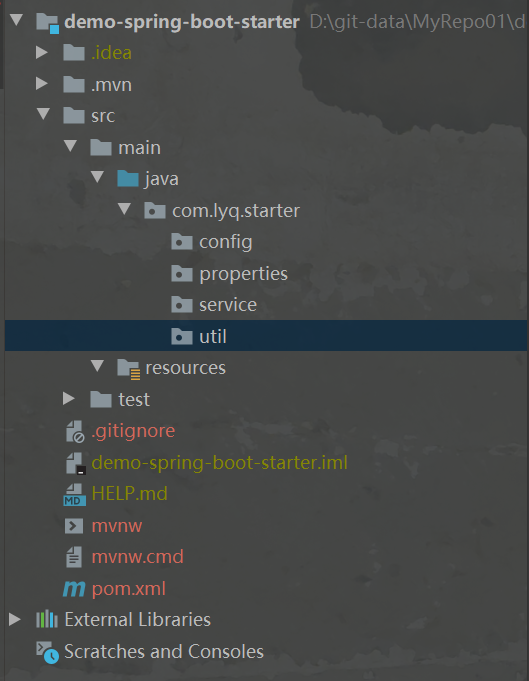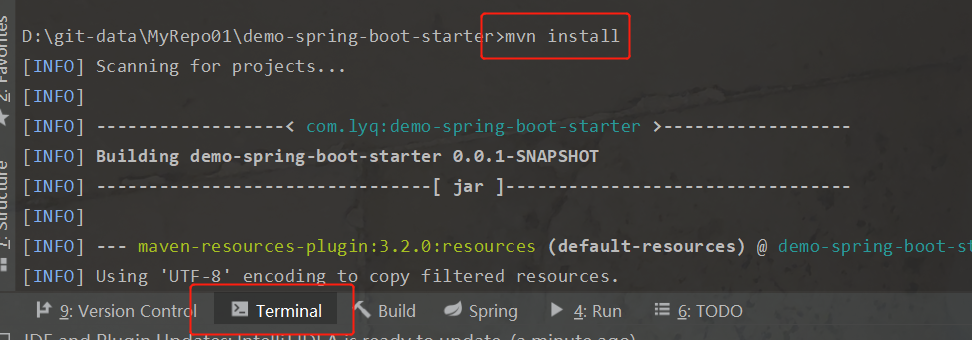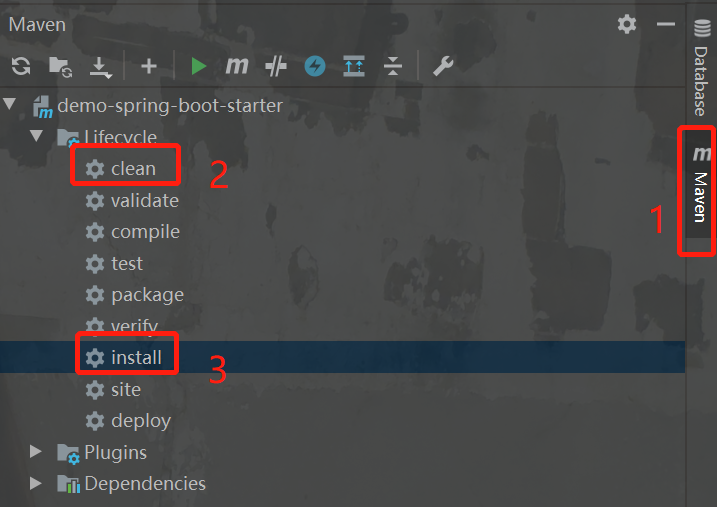1、简介
SpringBoot 最强大的功能就是把我们常用的场景抽取成了一个个starter(场景启动器),我们通过引入springboot 为我提供的这些场景启动器,我们再进行少量的配置就能使用相应的功能。即使是这样,springboot也不能囊括我们所有的使用场景,往往我们需要自定义starter,来简化我们对springboot的使用。
我们将这些可独立于业务代码之外的功配置模块封装成一个个starter,复用的时候只需要将其在pom中引用依赖即可,SpringBoot为我们完成自动装配。
2、自定义starter的命名规则
SpringBoot提供的starter以spring-boot-starter-xxx的方式命名的。官方建议自定义的starter使用xxx-spring-boot-starter命名规则。以区分SpringBoot生态提供的starter。
2.1 官方命名空间
- 前缀:spring-boot-starter-xxx
- 模式:spring-boot-starter-模块名
- 举例:spring-boot-starter-web、spring-boot-starter-jdbc
2.2 自定义命名空间
- 后缀:xxx-spring-boot-starter
- 模式:模块-spring-boot-starter
- 举例:mybatis-spring-boot-starter
3、自定义starter实现
3.1 新建工程
命名为demo-spring-boot-start
项目结构如下:

3.2 pom依赖
1
2
3
4
5
6
7
8
9
10
11
12
13
14
15
16
17
18
19
20
21
22
23
24
25
26
27
28
29
30
31
32
| <?xml version="1.0" encoding="UTF-8"?>
<project xmlns="http://maven.apache.org/POM/4.0.0" xmlns:xsi="http://www.w3.org/2001/XMLSchema-instance"
xsi:schemaLocation="http://maven.apache.org/POM/4.0.0 https://maven.apache.org/xsd/maven-4.0.0.xsd">
<modelVersion>4.0.0</modelVersion>
<parent>
<groupId>org.springframework.boot</groupId>
<artifactId>spring-boot-starter-parent</artifactId>
<version>2.6.1</version>
<relativePath/>
</parent>
<groupId>com.lyq</groupId>
<artifactId>demo-spring-boot-starter</artifactId>
<version>0.0.1-SNAPSHOT</version>
<name>demo-spring-boot-starter</name>
<description>Demo project for Spring Boot starter</description>
<properties>
<java.version>1.8</java.version>
</properties>
<dependencies>
<dependency>
<groupId>org.springframework.boot</groupId>
<artifactId>spring-boot-configuration-processor</artifactId>
<optional>true</optional>
</dependency>
<dependency>
<groupId>org.springframework.boot</groupId>
<artifactId>spring-boot-starter</artifactId>
</dependency>
</dependencies>
</project>
|
3.3 定义配置信息映射的实体类
@ConfigurationProperties(prefix = "demo") 它可以把相同前缀的配置信息通过配置项名称映射成实体类,比如我们这里指定 prefix = "demo" 这样,我们就能将以demo为前缀的配置项拿到了。
ps:其实这个注解很强大,它不但能映射成String或基本类型的变量。还可以映射为List,Map等数据结构。
1
2
3
4
5
6
7
8
9
10
11
12
13
14
15
16
17
18
19
20
21
22
23
24
25
| package com.lyq.starter.properties;
import org.springframework.boot.context.properties.ConfigurationProperties;
@ConfigurationProperties(prefix = "demo")
public class DemoProperties {
private String sayWhat;
private String toWho;
public String getSayWhat() {
return sayWhat;
}
public void setSayWhat(String sayWhat) {
this.sayWhat = sayWhat;
}
public String getToWho() {
return toWho;
}
public void setToWho(String toWho) {
this.toWho = toWho;
}
}
|
3.4 定义一个service
1
2
3
4
5
6
7
8
9
10
11
12
13
14
15
16
17
18
19
| package com.lyq.starter.service;
import com.lyq.starter.properties.DemoProperties;
public class DemoService {
DemoProperties demoProperties;
public DemoProperties getDemoProperties() {
return demoProperties;
}
public void setDemoProperties(DemoProperties demoProperties) {
this.demoProperties = demoProperties;
}
public String say(String name){
return name + "对" + demoProperties.getToWho() + "说:“" + demoProperties.getSayWhat() + "”";
}
}
|
3.5 定义配置类
这里,我们将DemoService类定义为一个Bean,交给Ioc容器。
@Configuration声明一个类作为配置类,代替xml文件。ps:通常 @Configuration 和 @Bean 是一起使用的
@EnableConfigurationProperties 注解。该注解是用来开启对3步骤中 @ConfigurationProperties 注解配置Bean的支持。
当然了,也可以在 @ConfigurationProperties 注解的类上添加 @Configuration 或者 @Component 注解
@ConditionalOnProperty 注解控制 @Configuration 是否生效。简单来说也就是我们可以通过在yml配置文件中控制 @Configuration 注解的配置类是否生效。
1
2
3
4
5
6
7
8
9
10
11
12
13
14
15
16
17
18
19
20
21
22
23
24
25
26
27
28
29
30
31
| package com.lyq.starter.config;
import com.lyq.starter.properties.DemoProperties;
import com.lyq.starter.service.DemoService;
import org.springframework.beans.factory.annotation.Autowired;
import org.springframework.boot.autoconfigure.condition.ConditionalOnProperty;
import org.springframework.boot.context.properties.EnableConfigurationProperties;
import org.springframework.context.annotation.Bean;
import org.springframework.context.annotation.Configuration;
@Configuration
@EnableConfigurationProperties(DemoProperties.class)
@ConditionalOnProperty(
prefix = "demo",
name = "isopen",
havingValue = "true"
)
public class DemoAutoconfiguration {
@Autowired
private DemoProperties demoProperties;
@Bean
public DemoService demoService(){
DemoService demoService = new DemoService();
demoService.setDemoProperties(demoProperties);
return demoService;
}
}
|
3.6 重点:创建spring.factories
在resource目录下,新建META-INF文件夹,然后创建spring.factories文件。
目录结构如下:

在该文件中加入如下配置,该配置指定上步骤中定义的配置类为自动装配的配置:
1
2
3
|
org.springframework.boot.autoconfigure.EnableAutoConfiguration=\
com.lyq.starter.config.DemoAutoconfiguration
|
3.7 生成starter
在demo-spring-boot-starter工程中,使用terminal终端执行mvn clean、mvn install

或者直接点击运行maven插件:

至此,一个自定义的starter新鲜出炉。(本人配置了mvn本地仓库,看下本地仓库中starter):

3.8 测试
3.8.1 新建测试工程
3.8.2 引入自定义start依赖
1
2
3
4
5
| <dependency>
<groupId>com.lyq</groupId>
<artifactId>demo-spring-boot-starter</artifactId>
<version>0.0.1-SNAPSHOT</version>
</dependency>
|
3.8.3 配置application.yml
1
2
3
4
| demo:
isopen: true
to-who: 李四
say-what: 自定义的starter测试成功
|
3.8.4 编写测试类
1
2
3
4
5
6
7
8
9
10
11
12
13
14
15
16
| package com.lyq.controller;
import com.lyq.starter.service.DemoService;
import org.springframework.web.bind.annotation.GetMapping;
import org.springframework.web.bind.annotation.RestController;
@RestController
public class StarterTestController {
@Resource(name = "demoService")
private DemoService demoService;
@GetMapping("/say")
public String sayWhat(){
return demoService.say("张三");
}
}
|
3.8.5 验证结果

点击这里查看源码





